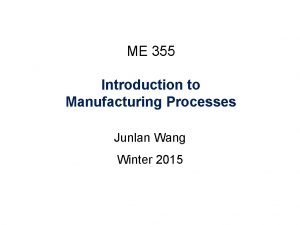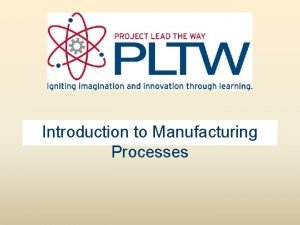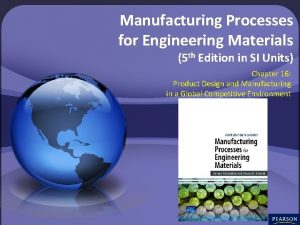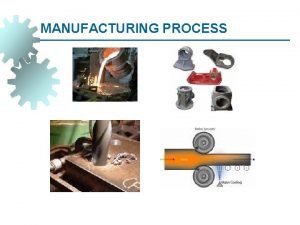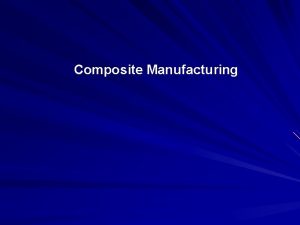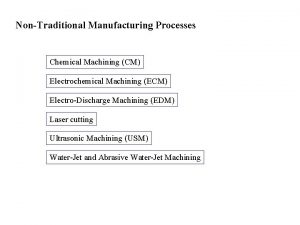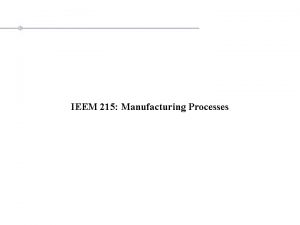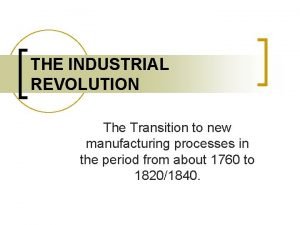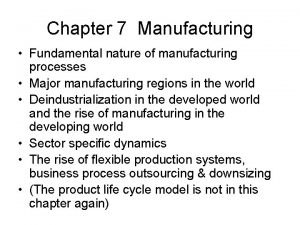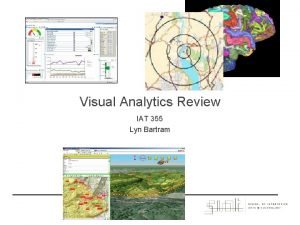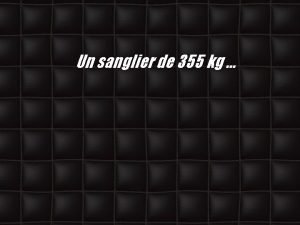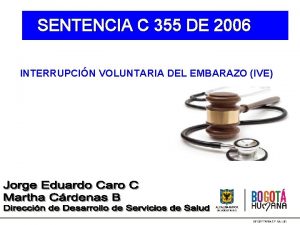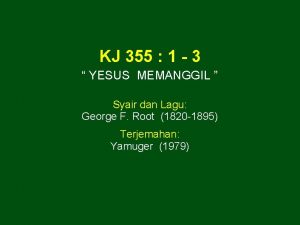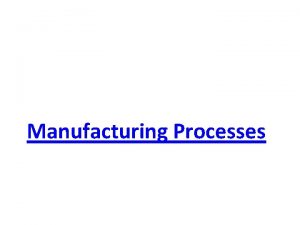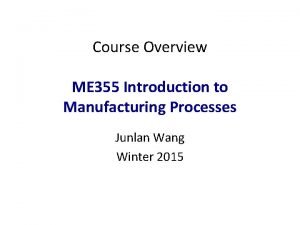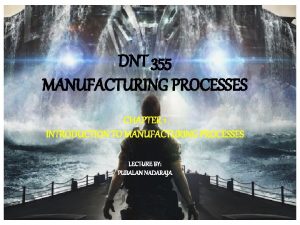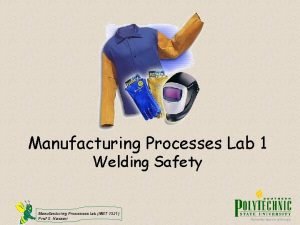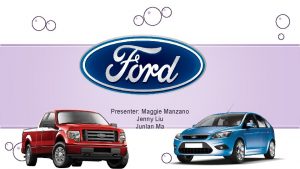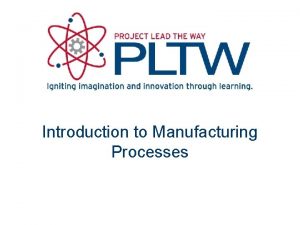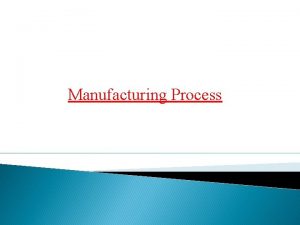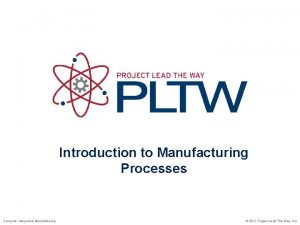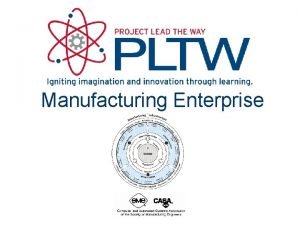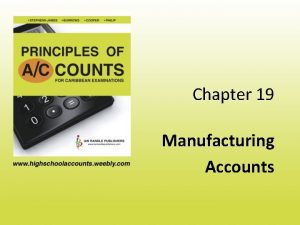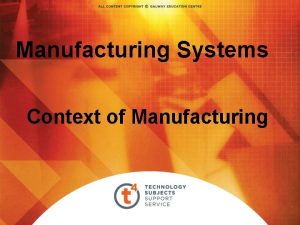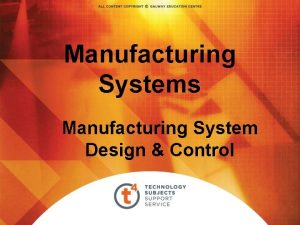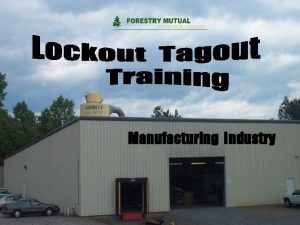ME 355 Introduction to Manufacturing Processes Junlan Wang



















- Slides: 19

ME 355 Introduction to Manufacturing Processes Junlan Wang Winter 2015 4/2 ME 355 Spring 2014 1

General Terminology • • • 4/2 Manufacturing Concurrent Engineering Design for Manufacturing, Assembly, Disassembly, Service Green Design, Sustainable Manufacturing, Product Life Cycle Materials Selection, Process Selection Computer Integrated Manufacturing Lean Production, Agile Manufacturing Quality Control, Total Quality Assurance Manufacturing Cost, Global Competitiveness ME 355 Spring 2014 2

Manufacturing • • • 4/2 The process of converting raw materials into products; encompasses the deign and manufacturing of goods using various production methods and techniques. ~ came from Latin “manu factus” – made by hand Interchangeably used with “production” Manufactured item has monetary worth (added value) than raw materials Manufacturing is closely linked to national and global economy ME 355 Spring 2014 3

• • • Importance of Manufacturing to Economy Traditionally, higher % contribution of manufacturing, higher GDP Exceptions: – – Nations with natural resources have higher living standards Nations with higher GDP have economic activity concentrated on high value-added products, e. g, airplanes, automobiles, electronics. Labor intensive manufacturing is associated with countries who follow the traditional trend. Source: After J. A. Schey with data from the World Development Report, World Bank, various years. 4/2 ME 355 Spring 2014 4

Concurrent Engineering • • • ~ Simultaneous Engineering A systematic approach integrating the design and manufacture of the products with the view toward optimizing all elements involved in the life cycle of the product Basic goal • • • Minimize time and cost in taking the product from conceptual design to production and introduction of the product to market Key to success: – – – 4/2 Minimize design and manufacture changes Full support of an organization’s top management Multifunctional and interacting work team, including support groups Utilization of all available state-of-the-art technologies ME 355 Spring 2014 5

Design for Manufacture, Assembly, Disassembly, and Service • • 4/2 Each part or component of a product must be designed to not only meets design requirements and specifications, but also to be manufactured economically and with relative ease. Product must be designed that individual parts can be assembled together with ease, speed, and minimum cost. Product must also be designed so that disassembly is possible with relative ease and require little time, enabling the product to be taken apart for maintenance, servicing, or recycling of their components. Product must be designed so that individual parts are easy to reach and service. ME 355 Spring 2014 6

Green Design, Sustainable Manufacturing, and Product Life Cycle • • Green Design - Design for Recycling (DFR) - Design for Environment (DFE) Sustainable Manufacturing – – • 4/2 Reducing waste of materials at their source by refinement in product design and the amount of materials used Reducing the use of hazardous materials in products and processes Ensuring proper handling and disposal of all waste Improving waste treatment and recycling and reuse of materials Product Life Cycle (PLC) – – – Product development Market Introduction Growth Maturation Decline ME 355 Spring 2014 7

Materials Selection • Materials used in today’s manufacturing – Metals • • – – • • 4/2 Ferrous metals: carbon steels, alloy steels, stainless steels, and tool and die steels Nonferrous metals and alloys: Al, Mg, Cu, Ni, superalloys, Ti, refractory metals (Mb, Nb, W, Ta), beryllium, Zr, low melting alloys (lead, zinc and tin), and precious metals Plastics: Thermosets, thermoplastics, and elastomers Ceramics: Glass ceramics, glasses, graphite, and diamond Composites: Reinforced plastics, metal-matrix and ceramics-matrix composites, and honeycomb structures Nanomaterials, shape-memory alloys, metal foams, amorphous alloys, super conductors and semiconductors Material properties: mechanical, physical, chemical, manufacturing Cost and availability, Service life and recycling ME 355 Spring 2014 8

Manufacturing Process Selection • Categories of manufacturing processes – – – • 4/2 Casting: expandable molding and permanent molding Forming and shaping: rolling, forging, extrusion, drawing, sheet forming, powder metallurgy and molding Machining: turning, boring, drilling, milling, planing, shaping, broaching, grinding, ultrasonic machining; chemical, electrical, and electrochemical machining and high energy electron beam machining Joining: welding, brazing, soldering, diffusion bonding, adhesive bonding and mechanical joining Micro and nano manufacturing: surface micromachining, dry and wet etching, and electroforming Finishing: honing, lapping, polishing, burnishing, deburring, surface treating, coating and plating Factors affecting process selection • • Component/part shape Materials characteristics – castability, formability, machinability, weldability, etc Part size and dimensional accuracy Manufacturing and operational cost ME 355 Spring 2014 9

Computer Integrated Manufacturing • • 4/2 CIM applications – – – Control and optimization of manufacturing process Materials handling Assembly Automated inspection and testing of products Inventory control Management Advantages – – Improved responsiveness Better use of materials, machinery and personnel, reduction in inventory Better control of production and management Manufacturing high-quality at low-cost ME 355 Spring 2014 10

Lean Production and Agile Manufacturing • Lean Production (~lean manufacturing): a manufacturing practice that considers the expenditure of resources for any goals other than creating values for the end customer as wasteful, thus a target for elimination • • – • The efficiency of the machinery and equipment used in the operation while maintaining and improving quality (equipment) The number of personnel involved in a particular operation (personnel) A thorough analysis in order to reduce the cost of each activity, including both productive and nonproductive labor (activity cost effectiveness) Goal: continuously improving the efficiency and profitability by reducing all types of waste from its operation (“ 0”-base waste) and dealing with problems asap. Agile Manufacturing – – Ensuring flexibility (agility) in the manufacturing enterprise so that it can quickly respond to changes in product variety and demand, and customer needs • • • 4/2 A major assessment of each activity of a company regarding the efficiency and effectiveness of its operations (company operation) To be achieved through Machines and equipment with Built-in flexibility (reconfigurable machines) using modular components that can be arranged and rearranged in different ways Advanced computer hardware and software Reduced changeover time and implementing advanced communication systems. ME 355 Spring 2014 11

Quality Assurance and Total Quality Management • • 4/2 Product quality affects marketability and customer satisfaction Quality Assurance (QA) is now part of the concurrent engineering process and is built into every stage of the manufacturing process Total Quality Management (TQM) and QA are the responsibility of everyone involved in the design and manufacturing of a product Product liability – consequence of using a product that has malfunctioned, causing bodily injury, or even death, and the financial loss to a person as well as the organization manufacturing the product. ME 355 Spring 2014 12

Manufacturing Cost and Global Competitiveness • • • Manufacturing cost – – – ~40% of product selling price Includes cost of materials, tooling and labor, as well fixed and capital costs Can be minimized by optimizing design, least cost material, while maintaining the intended function and characteristics, and materials substitution. Global competitiveness impacts manufacturing – – – Markets become multinational and dynamic Demand for high-quality, low-cost and timely delivery Increased product variety, complexity and shorter product life cycle Wide disparity in manufacturing labor cost leads to outsourcing Outsourcing – a practice of taking internal company activities and paying outside firm to perform them. 4/2 ME 355 Spring 2014 13

General Trend in Manufacturing • Better Materials • • 4/2 Better control of composition, purity, and defects to enhance their overall properties, manufacturing characteristics, reliability, and service life while keeping cost low Better recyclability, and higher strength-, stiffness-to-weight ratio materials due to concerns over energy and material saving Better tool, die and mold materials with better resistance to process variable, thus higher efficiency and economics of manufacturing processes Improved efficiency and reliability of all manufacturing processes, equipment and systems due to continuing development in computers, controls, industrial robots, automated inspection, handling and assembly, and sensor technology ME 355 Spring 2014 14

Summary • • • 4/2 Manufacturing and its importance to economy Concurrent Engineering Design for Manufacturing, Assembly, Disassembly, Service Green Design, Sustainable Manufacturing, Product Life Cycle Materials Selection, Process Selection Computer Integrated Manufacturing Lean Production, Agile Manufacturing Quality Control, Total Quality Assurance Manufacturing Cost, Global Competitiveness, Outsourcing ME 355 Spring 2014 15

Pop Quiz • One one-plot, draw engineering stress-strain curve and true stress- strain curve of a ductile metal (e. g. , Al) – • Answer: – – 4/2 Label Young’s modulus, ultimate tensile strength, toughness, yield strength How does temperature affect the strength of a metal? How does the strain rate affect the strength of a metal? ME 355 Spring 2014 16

Factors affecting Process Selection • • Component/part shape Materials characteristics – castability, formability, machinability, weldability, etc Part size and dimensional accuracy Manufacturing and operational cost FIGURE 1. 7 Illustration of the range of common sizes of parts and the capabilities of manufacturing processes in producing these parts. 4/2 ME 355 Spring 2014 17

Concurrent Engineering • Sequential Process – – • Waste resource, waste time Concurrent Process – – – 4/2 Design ->Manufacturing All disciplines are involved in the earliest stages of product design Progress concurrently so iterations results in less wasted effort and time Key to success: well-recognized communication among and within disciplines FIGURE 1. 3 (a) Chart showing various steps involved in designing and manufacturing a product. Depending on the complexity of the product and the type of materials used, the time span between the original concept and the marketing of a product may range from a few months to many years. (b) Chart showing general product flow, from market analysis to selling the product, and depicting concurrent engineering. Source: After S. Pugh. ME 355 Spring 2014 18

Survey Results on Prior Manufacturing Experience • 15 students – good amount of experience – – Processes: casting/molding, CNC machining, Welding, cutting, drilling, waterjet … Jobs/interns at industry School teams/home projects: FSAE, UWHPS, high school robotics …. Materials: wood, metals, composites, plastics… …. . • • • 4/2 20 students – some limited machine shop experience 7 students – some experience with wood working 20 students – no experience ME 355 Spring 2014 19
 Junlan wang
Junlan wang List of manufacturing processes
List of manufacturing processes Manufacturing cost vs non manufacturing cost
Manufacturing cost vs non manufacturing cost Job vs process costing
Job vs process costing Commited cost
Commited cost Manufacturing cost vs non manufacturing cost
Manufacturing cost vs non manufacturing cost Additive manufacturing steps
Additive manufacturing steps Manufacturing process for engineering materials
Manufacturing process for engineering materials Classification of manufacturing process
Classification of manufacturing process Composites manufacturing processes
Composites manufacturing processes Nontraditional manufacturing processes
Nontraditional manufacturing processes Similar
Similar Industrial revolution transition
Industrial revolution transition Nature of manufacturing process
Nature of manufacturing process Concurrent processes are processes that
Concurrent processes are processes that Iat 355
Iat 355 Sentencia c-355 de 2006
Sentencia c-355 de 2006 Sanglier poids record
Sanglier poids record Que es la sentencia c 355 de 2006
Que es la sentencia c 355 de 2006 Haleluya 355
Haleluya 355
